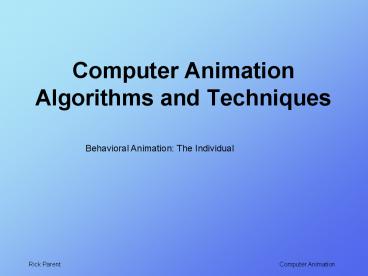Computer Animation Algorithms and Techniques PowerPoint PPT Presentation
1 / 18
Title: Computer Animation Algorithms and Techniques
1
Computer AnimationAlgorithms and Techniques
Behavioral Animation The Individual
2
Individual Autonomous Behavior
Autonomy Self-animated characters Internal
state psychology biology reasoning
abilities Perception reasoning about
environment
Behavior Manifestations of Individuality Body
Expressions and Gestures Facial
expressions Speech
3
Modeling Personality
Source Psychology literature
Personality long term qualities Emotions
short term Mood third level Basic
emotions happy, sad, fear, disgust, surprise,
anger
4
Reasoning
Biological urges hunger, survival, etc.
Rational objectives e.g., grab some fast food
Preferences e.g. doesnt like hamburgers
Suggested precedence classes of internal state
variables Imperatives Desires Suggestions
5
Knowledge of world
Vision other sense FoV occlusions
Memory permanent v. transient events
Background knowledge e.g., physics AI - e.g.,
semantic networks
6
Levels of Behavior
Hooks for the animator to impose control
7
Personality Models
Biology/evolutionary approaches brain
anatomy biochemistry personality genetics
personality Psychoanalytic approach psychometric
s Freud, Adler, Jung Adaptation
Theory traits passive, aggressive,
withdrawn Need theory Freud experiential
learning Arousal Theory absorb discharge
energy
8
Type Trait Theory
Type individuals slotted into a type e.g.
introvert v. extrovert, Type A v. Type B Trait
lie on gradation combination defines behavior in
situation e.g., aggressive, play,
order Internal states how perceptions dictate
emotional experience
9
Trait Theory
OCEAN openness, conscientiousness, extroversion,
agreeableness, neuroticism PEN psychoticism,
extraversion, neuroticism OCC how perceptions
dictate emotional experience
10
Laban Movement Analysis (LMA)
Tool for human motion description http//en.wikipe
dia.org/wiki/Laban_Movement_Analysis
Body - describes structural and physical
characteristics of the human body while moving.
Effort - the way a movement is done with respect
to inner intention.
Shape - the way the body changes shape during
movement.
Space - nvolves motion in connection with the
environment, and with spatial patterns, pathways,
and lines of spatial tension.
11
Speech Synthesis
12
Tools for Speech
Festival http//www.cstr.ed.ac.uk/projects/festiv
al/ Speech Synthesis System text to speech
MBROLA http//tcts.fpms.ac.be/synthesis/mbrola.ht
ml
ToBI http//www.ling.ohio-state.edu/tobi/
Tones and Break Indices
Praat http//www.fon.hum.uva.nl/praat/ Speech
analysis, synthesis, manipulation
13
EMOTE
Norm Badler at U.Penn
Speech driven movement and gestures Torso
arms Laban Movement Analysis Effort Shape
14
BEAT
Justine Cassell at M.I.T.
Input text marked up Generate non-verbal
behavior in sync with speech Facial expressions,
head body motions gestures http//www.cs.rutger
s.edu/village/ruth/
15
ruth
Doug DeCalro at Rutgers
http//www.cs.rutgers.edu/village/ruth/
16
Facial Expression
http//expression.sourceforge.net/
17
Facial Expression
Ken Perlin http//mrl.nyu.edu/perlin/
18
Dominant personality
AlphaWolf http//alumni.media.mit.edu/badger/alp
haWolf.html

